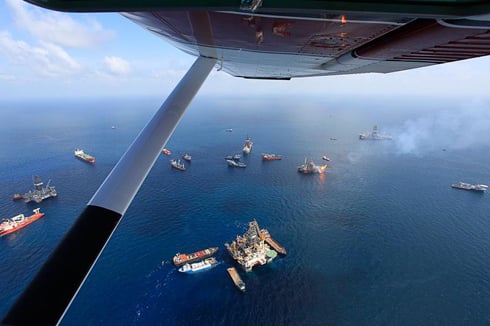One hundred and twenty species of life are erased from the planet each day.
Ninety percent of all the pelagic fish in the oceans are gone.
The Arctic ice cap is vanishing before our eyes as global temperatures continue to rise.
Here are some recent headlines from this summer:
- Greenland Ice Sheet loses 100 square miles, biggest loss since 1962 (Aug. 2010)
- Russia's drought-driven halt to wheat exports panics world grain markets (Aug. 2010)
- Pakistan's worst flood in recorded history claims some 1,100 lives (July, 2010)
- International study confirms accelerating warming trend (July, 2010)
- Rapid decline in phytoplankton population stuns scientists (July, 2010)
- Flash floods seen increasing as Milwaukee gets eight inches in two hours (July, 2010)
- Senate climate bill collapses (July, 2010)
- Coral reef deaths soar in record ocean heat (July, 2010)
- First half of 2010 was hottest such period on record (July, 2010)
- Carbon lobby launches "CO2 is Green" campaign (July, 2010)
- Massive Greenland glacier retreats one mile in one night (July, 2010)
- Military declares climate change "a catalyst for conflict" (June, 2010)
- Malaria soars with small rainforest reductions (June, 2010)
- Oceans have stored more heat than they released since 1993 (May, 2010)
- Climate change is causing "irreversible" destruction of ocean life systems (June, 2010)
- Himalayan glacier melt puts 60 million people at risk of food shortages (June, 2010)
- Warming pushes many small mammal species to the brink (June, 2010)
This is happening not because any of us want it, but because those in power, answerable only to their corporate sponsors, are playing out their mantra of "every means should be used to further expansion."
Expansion of growth. Expansion of profits. Expansion of power.
Mumford has said a change in this mindset of perpetual expansion would likely only happen with "an all-out fatal shock treatment, close to catastrophe, to break the hold of civilized man's chronic psychosis."
We have already had many of these "fatal shock treatments:" the Exxon Valdez spill, the Union Carbide disaster in Bhopal, Chernobyl, Hiroshima, Nagasaki, Agent Orange, Love Canal, Three Mile Island, the Seveso Italian dioxin crisis, the Baia Mare cyanide spill. These are just a few. It's a long list.
And, now, we can add the BP disaster in the Gulf of Mexico.
-
View of "The Source." (Area of Gulf of Mexico directly above the Macondo Well after the explosion and sinking of the Deepwater Horizon Rig.) (Photo: Erika Blumenfeld 2010)
BP's oilrig in the Gulf of Mexico exploded in April and, for 36 hours, its flames released immeasurable amounts of toxins into the atmosphere before it sunk into the depths. We now know that the vast majority of the oil that gushed from the well was intentionally submerged by BP via heavy use of dispersants at the wellhead, so most of the oil is floating around in giant undersea plumes, one of which is ten miles long, three miles wide and 300 feet thick. They are like oil bergs - what we see on top of the water is a mere fraction of what lies beneath. This was not an oil leak. This was a volcano of oil gushing into the Gulf of Mexico.
If independent estimates of the amount of oil released into the Gulf are correct, as many as one Exxon Valdez load of oil (250,000 barrels worth) was being released into the Gulf of Mexico every two and a half days. That means 8,700,000 barrels of oil, or 34 Exxon Valdez's worth, were released into the Gulf of Mexico.
Conversely, what actions have been taken to bring BP
to account? Will the CEO likely spend time in jail? Government officials
and institutions that have colluded with BP - how about them being
brought to justice?
When the Exxon Valdez struck a reef in Prince William Sound in Alaska in
1989, the incident was considered to be among the most devastating
human-caused environmental disasters in history.
Even after the surface oil is cleaned up in the Gulf of Mexico, scientific studies already show (as they have shown in Prince William Sound) that oil can remain trapped in the seabed for decades, continuing to contaminate and kill fish, shrimp, crabs and bird life. To this date, a maximum of only 14 percent of the oil spilled in that disaster has been recovered. As you read this, BP is scaling down the response efforts to the Gulf disaster.
Next Page 1 | 2 | 3 | 4 | 5 | 6 | 7
(Note: You can view every article as one long page if you sign up as an Advocate Member, or higher).





